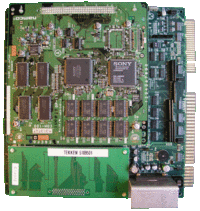Namco System 11
The Namco System 11[lower-alpha 1] is a 32-bit arcade system board developed jointly by Namco and Sony Computer Entertainment. Released in December 1994, it is a successor to the Namco System 22, the company's first 3D arcade system. The System 11 is directly based on the PlayStation, Sony's first home video game console, using a 512 KB operating system and several custom processors. An upgraded version of the System 11, the Namco System 12[lower-alpha 2], was released in 1996 and features a faster processing power. Tekken was the first game to use the System 11.
 | |
| Manufacturer | Namco Sony Computer Entertainment |
|---|---|
| Type | Arcade system board |
| Release date | December 1994 |
| Discontinued | February 1999 |
| Operating system | 512 KB |
| CPU | MIPS R3000A 32-bit |
| Predecessor | Namco System 22 |
| Successor | Namco System 12 |
History
Although the System 11 was technically inferior to Sega's Model 2 arcade board, its lower price made it an attractive prospect for smaller arcades.[1][2] According to the June 1995 issue of Edge:
Namco took a significant risk in basing its Tekken coin-op on raw PlayStation hardware, considering that it would be competing directly with Sega's Model 2-powered Virtua Fighter 2 ... For once, a home system can boast an identical conversion of a cutting-edge coin-op ... Namco's research section managing director, Shegeichi Nakamura ... explains: "When Sony came along we decided to go for a low-cost system—in short, we've left the big arcade stores to Sega and VF2 and Tekken has been sold to smaller arcade centres" ... Namco has a further four titles planned for System 11, all of which are likely to make the jump to the PlayStation.[1]
Technical specifications
- Main CPU: MIPS R3000A 32-bit RISC processor @ 33.8688 MHz, Operating performance - 30 MIPS, Instruction Cache - 4KB
- BUS: 132 MB/s.
- OS ROM: 512 KB
- Sound CPU: Namco C76 (Mitsubishi M37702)
- Sound chip: Namco C352
- Main RAM: 2 MB
- Video VRAM: 2 MB
- Sound RAM: 512 kB
- Graphical Processor: 360,000 polygons/s, sprite/BG drawing, Adjustable framebuffer, No line restriction, 4,000 8x8 pixel sprites with individual scaling and rotation, Simultaneous backgrounds (parallax scrolling)
- Sprite Effects: Rotation, Scaling up/down, Warping, Transparency, Fading, Priority, Vertical and Horizontal Line Scroll
- Resolution: 256x224 - 640x480
- Colors: 16.7 million colors, Unlimited CLUTs (Color Look-Up Tables)
- Other Features: custom geometry engine, custom polygon engine, MJPEG decoder
Games
| Year | Title | Genre | Ref. |
|---|---|---|---|
| 1994 | Tekken | Fighting | [3] |
| 1995 | Tekken 2 | Fighting | [4] |
| Tekken 2 Ver.β | Fighting | ||
| Soul Edge | Fighting | [5] | |
| 1996 | Dunk Mania | Sports | [6] |
| Pocket Racer | Racing | ||
| Xevious 3D/G | Vertical-scrolling shooter | [6] | |
| Dancing Eyes | Puzzle | [7] | |
| Soul Edge Ver. II | Fighting | ||
| J-League Soccer: Prime Goal EX | Sports | ||
| 1997 | Star Sweep | Sports | |
| 1998 | Point Blank 2 | Lightgun shooter | |
| Family Bowl | Sports | ||
| Kosodate Quiz My Angel 3: My Little Pet | Quiz | ||
Notes
References
- "Tekken". Edge. Imagine Media. 3 (21): 66–70. June 1995.
- Tokyo Drifter (April 2002). "Virtua Fight Club". GamePro. 14 (163): 48–50.
- "Tekken". GamePro (68). IDG. March 1995. p. 38.
- "Tekken 2". Maximum: The Video Game Magazine. Emap International Limited (1): 21. October 1995.
- "Soul Edge". Next Generation. Imagine Media (12): 123. December 1995.
- "The 1996 AOU Coin-Op Show: 3D Arcade Gaming Enters the Next Level!". Maximum: The Video Game Magazine. Emap International Limited (5): 116–7. April 1996.
- Ylärakkola, Arttu (2 February 2007). "'Arcade Obscurities' - Namco's Dancing Eyes". GameSetWatch. Game Network. Archived from the original on 11 January 2019. Retrieved 26 March 2020.
